Dr Sheila Sweetinburgh is delighted that Dr Diane Heath, Research Fellow in CKHH, has taken over the Centre’s blog this week for some very exciting news! I (Diane) am delighted to announce my project on Medieval Animals Heritage in East Kent has been awarded a National Lottery Heritage Fund grant of £99,800, so first things first: Thank you Lottery Heritage Fund and thanks National Lottery players too.
The money is for an ambitious programme of local heritage events, exhibitions, medieval ‘safaris’, and research outputs involving our Canterbury Christ Church University students, local communities, schoolchildren, and families – especially families with special needs children who are at the heart of this project. Mental health issues associated with COVID and lockdowns are especially serious for SEND children and there is a shortage of family-friendly SEND activities in East Kent. The proposed activities will help families engage in free, accessible, and fun events that will actively aid the acquisition and transmission of local heritage knowledge. We shall work with the children’s charity SNAAP and other support groups to host our special medieval safaris for local families with children with special needs that will include ‘tail-telling’ sessions with professional artists, storytellers, and musicians – carefully family-bubbled trips to Wildwood, the Powell-Cotton Museum, Dover Museum, and Canterbury and Rochester Cathedrals, for often families have been shielding and are nervous about going to new places. There will be walks in the woods and mermaid sand-sculpting on Thanet beaches too. We shall send out giftboxes and goody bags with information and fun invitations to emphasise this project is about happiness and wellbeing.
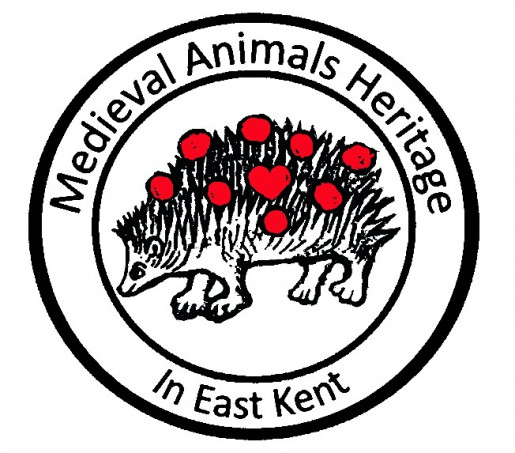
Please welcome our mascot, Harriet Hedgehog, designed by Penny, and chosen because medieval hedgehogs were considered heretics as they stole grapes from the Lord’s vineyards to feed their hoglets, as depicted in this splendid miniature from the Ashmole Bestiary now in the Bodleian Library.
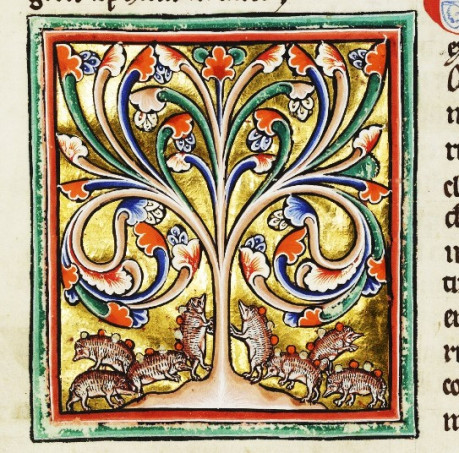
Photo: © Bodleian Libraries, University of Oxford, CC-BY-NC 4.0
The grant success is very much due to the enormous amount of advice, help and support received in Canterbury Christ Church University from my friends at our Centre for Kent History and Heritage – Sheila Sweetinburgh, Claire Bartram, and project co-ordinator Penny Bernard, the generous aid from Nicole Robinson and Harriet Kersey in the Research Funding Unit, the unstinting encouragement and expertise from Peter Vujakovic on green heritage, and the kind support of many colleagues in History and within the Faculty of Arts, Humanities, and Education.
Large as the debt is to all my Canterbury Christ Church University colleagues, it is more than matched by the help and support received from local communities, heritage sites, schools, charities, churches, Cathedrals, and colleagues ‘up the hill’ at University of Kent. Thank you, everyone, thank you, thank you, thank you, this is your project.
So, what’s the project all about? Why East Kent? And why Medieval Animals? We all know recent times have been challenging and Covid has hurt more than the economy, it has hurt our families, our friends, our whole area has been blighted. The impending climate emergency will require even greater efforts to ensure the survival of our homes and the people and places, animals, plants and landscapes we love – as sea levels rise and damaged eco-systems threaten to fail. Now, every aspect of our work – and that includes this project – must be sustainable, flexible, and resilient. But we need more than green, we need cheering up. We need warmth, friendship, fun and hope and that is what this project sets out do by helping everyone share in an amazing and unsung local heritage.
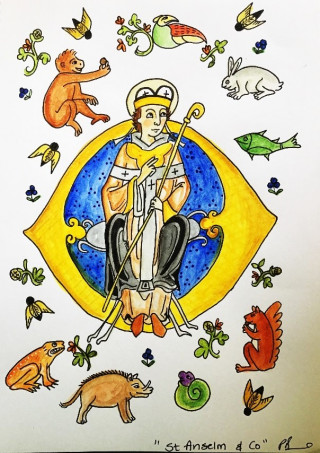
Our project focuses on the rich diversity of Medieval Animals Heritage in East Kent that spans nearly a thousand years, connected to the life and legacy of a remarkable man, Saint Anselm, the theologian and Archbishop of Canterbury (1093-1109). Anselm oversaw a spiritual and intellectual renaissance in East Kent. Less well-known is Anselm’s emphasis on creation and the natural world. Medieval animals have been linked to St Francis, but this project brings the much more ancient bestiary tradition to the fore and shows how these books of beasts were used by St Anselm and his kinsman Honorius in East Kent to connect spirituality to people’s emotions in what became an important local and international heritage. Anselm is in effect our early St Francis with his stories on the soaring Eagle, the shy Little Owl, the frightened Hare, and the beautiful Pearl of the oyster. Honorius drew on the early bestiary to create stories to be carved and painted in churches – such as the Lion breathing life into his stillborn cubs as a figure for hope, and pelicans reviving their chicks.
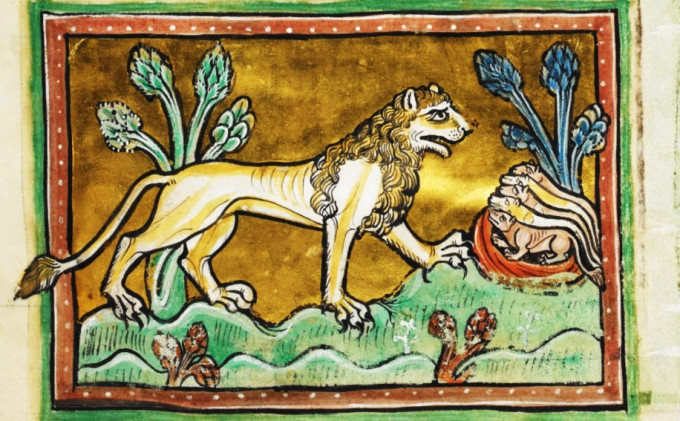
Medieval Animals are just like ordinary animals but include all the ones we want to imagine exist such as the Unicorn and the Phoenix, centaurs and mermaids, griffins and of course, dragons. Think Pokemon and Fantastic Beasts but weirder and more fun. These medieval animal tropes encompass an array of emotions that are easy to understand and are helpful for children on the autistic spectrum – what could be angrier than a Dragon, more loyal than a dog – and funnier than a Bonnacon – an ox whose superpower is a huge hot wet fart!
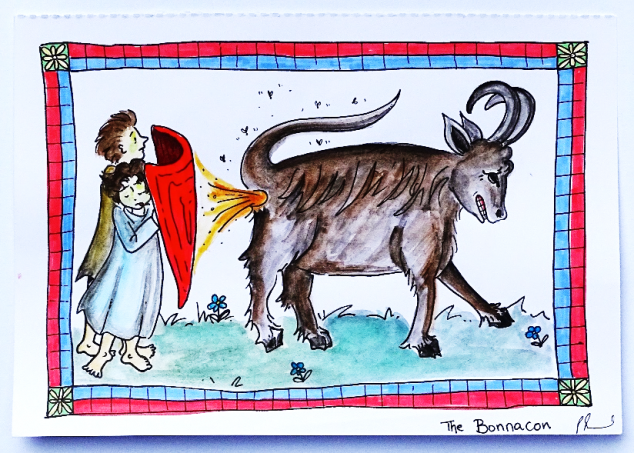
Our amazing local medieval animal culture, stories, and values are neither talked about nor taught; we are in danger of losing an immensely rich seam of community heritage. Walter Benjamin wrote, ‘every image of the past that is not recognized by the present as one of its own concerns threatens to disappear irretrievably.’ Through this project, we can rediscover a living heritage, placing ‘ourselves next to the animals’ to open up ‘a new way of imagining the past’ (Professor Erica Fudge). By linking key eco-heritage sites with medieval sites many local people, including children, will better understand their local medieval animals heritage via living creatures, stunning medieval art, and zooarchaeological material and make it a part of their own stories.
The project will bring together different surviving aspects of the heritage, from misericords in Minster, to the wolves of Wildwood, and to local zooarchaeology and the amazing animal material culture housed in the Powell-Cotton Museum and create a reliable and coherent account that will lay foundations for future generations to enjoy. St Anselm and Honorius appealed to local laypeople using bestiary tropes and beautified medieval churches with animal art, because they knew the wide-ranging and intense appeal of animals as bearers of emotional meanings. Medieval Animals Heritage combines the same appeal with differentiated heritage learning, meaning everyone can join in no matter what challenges and barriers they face.
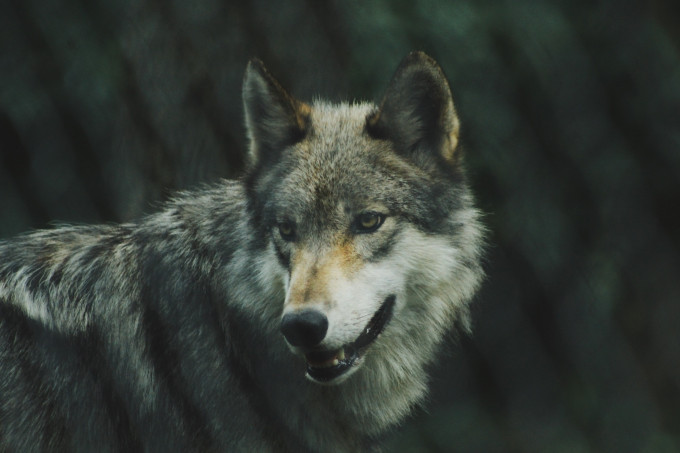
We have even more exciting plans – for example, thanks to the amazing support of Dr Tim Ireland at Kent and the Eastbridge Hospital Trustees, we shall bring a competitive, architect-designed, eco-heritage learning space into a wonderful and healing place – the beautiful medieval Franciscan Gardens in Canterbury. A Design Exhibition at the Templeman Museum will showcase the University of Kent School of Architecture student designs and include Special Collections exhibits and a brilliant Medieval Animal Virtual Tapestry that uses artworks and recordings made by children at our Medieval Animals safari workshops. We shall be asking for volunteers to research local medieval animals’ heritage, traditions and folklore and construct medieval backstories for the native and now rare species at Wildwood. We are calling the research hub our ARChive, please do join us.
Making the research accessible is essential, so we shall translate the earliest Latin bestiary from Kent, in Zoom (and we hope later – pub) sessions aptly called ‘Beastly Latin’ (Latinobarbus), for everyone with rusty Latin or a wish to learn it. The translations of each chapter will then be turned into modern stories to appeal especially to children and recorded as podcasts on our project website.
More? We shall be working with Rochester Cathedral for their exhibition to celebrate the 900th anniversary of their wonderful Textus Roffensis, a twelfth-century book made in Rochester that contains laws and charters dating back to the earliest Kent kingdom – and including a magical charm written in English to find a stolen horse. Canterbury Archives are kindly hosting a medieval animal workshop with images from their wonderful medieval collections illuminating the ceiling of the Archives. There is also an open academic conference being held at Canterbury Christ Church University to look forward to with a concurrent exhibition using exhibits our volunteer researchers have chosen thanks to the generosity of the Powell-Cotton Museum.
Still more? We are asking for volunteers to make ‘green’ journeys – by foot, bike, bus or carshare to local churches to ‘snap and map’ the stone, wooden and painted medieval animals that adorn these East Kent treasures – and to see fantastic native species at Wildwood and examine creatures that were known to medieval Kent people and are now preserved at Powell-Cotton Museum. We shall have fortnightly volunteer tea (and cake) sessions to work on research and the website together; this is a very friendly project. Our volunteers can then upload their research and create ‘I-Spy’ fun for families to download and then visit the same churches and create their own family stories. There’s a tiny stained-glass leopard in Monkton Church, what adventures could children imagine he might go on?
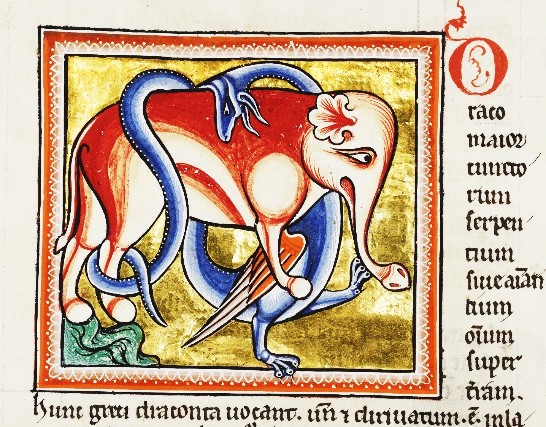
Photo: © Bodleian Libraries, University of Oxford, CC-BY-NC 4.0
Even more? In our terrific Education department Claire Stow is kindly supporting the roll-out of Medieval Animals Heritage Activities into local primary schools which means we can cascade the heritage to even more local families. The fun includes junk-modelling animal costumes for assemblies and local parades. We hope to link up with Royal Harbour Academy for a special Medieval Animals Exhibition so we can include older pupils in the project. Our students will be trained in Wellbeing and Special Needs care by Tracey Wornast and Georgina Keith-Hill. We are hosting a stand at Freshers’ Fayre on Wednesday 22 September (kindly arranged by Chi Lau and Elizabeth Carr) to ask student volunteers to attend a masterclass training, picnic lunch, and Heritage trip the very next day. We hope our terrific students will want to take part in our social media programme, the research hub, and the zoo, beach, and woods walks, learn conservation skills and exhibition and conference management and hugely enjoy a unique heritage experience at CCCU. In October we shall hold another masterclass set of sessions for local volunteers and SEND family members and then we really get going.
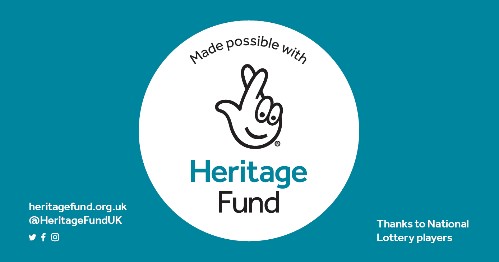
Are you wondering, like the Lottery Heritage Fund were initially, how we are managing to do this on a budget of slightly under £100,000? The answer is that Penny and I have budgeted very carefully indeed but much more importantly, we have received a great deal of very generous in-kind support. Thank you everyone for your enthusiasm, your passion, and your optimism – here’s to a great new project.
 Centre for Kent History and Heritage
Centre for Kent History and Heritage Sheila Sweetinburgh
Sheila Sweetinburgh 5669
5669


Great news! Congratulations, Diane, you worked hard for this.
Thanks Mary, yes Diane did and hugely deserved!
I’m not sure where Hedgehogs fit in with this project, however, i am the Hedgehog “Champion” at Monkton Nature Reserve and have carried out presentations on “how to help and save them” at a school and various gardening and local residents groups.
Thanks Roy for letting us know about your expertise and I’m sure Diane will be in touch.
Best wishes, Sheila
Wow, well done. I know a lot goes into doing these bids so congratulations. I’m sure it will benefit many, many people, adults and children alike.
Hello Kaye, thanks very much and yes as you can gather Diane has worked very hard on this bid because she is passionate about the project and the benefits it will bring.
Best wishes, Sheila
Congratulations, this looks brilliant! I’m so excited about this, at a personal and professional level. I think my organisation is well placed to support some of the project activities, so would love to get in touch with Diane.
Hello Dawn, many thanks for this and I am sure Diane would be delighted to hear from you at: diane.heath@canterbury.ac.uk so please do get in touch with her.
Best wishes, Sheila
These items of medieval animals, like the The Aberdeen Bestiary, are truly amazing. As an American, I am always curious how many English folks (if you’ll excuse me saying so, no offense meant) often focus on some sort of class hierarchy when analyzing things, medieval or modern. I find it in old British TV shows (brought to the US at least), modern youtube videos, and I can’t help but notice it here as well. It both fascinates and bothers me- from my cultural background, we are all equal, and to emphasize something happening due to someone being wealthy is for some reason off-putting… even if it is reality! Anyway, thanks for all these interesting findings and especially the analysis of each.
Hello Jason, thanks for your ideas but I’m afraid that’s how society worked and continues to work in many ways. However, delighted to hear that your found it all interesting.